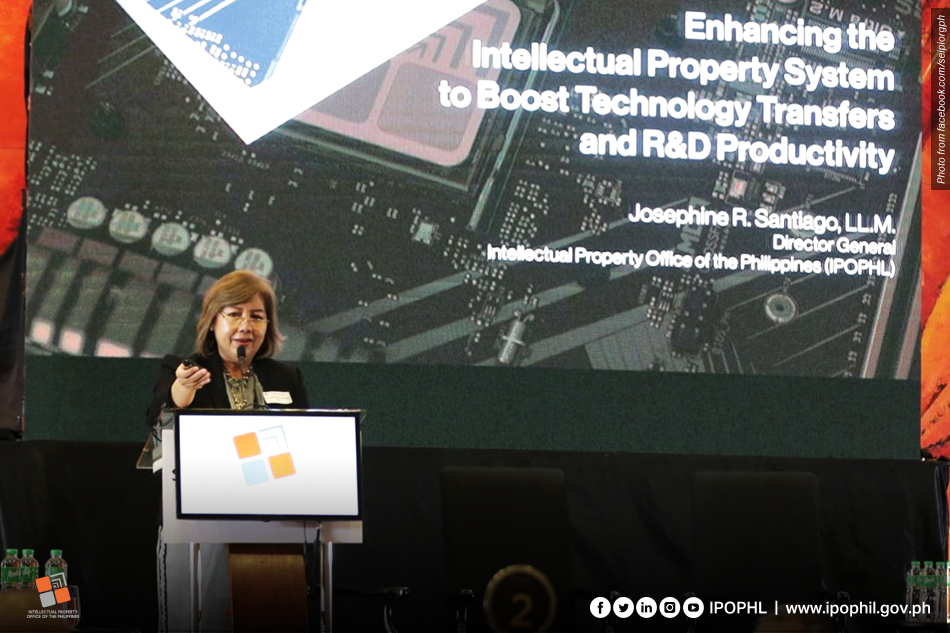IPOPHL bats for first PH-registered integrated circuit layout design
Published on November 13, 2019

The Intellectual Property of the Philippines (IPOPHL) has challenged players of the local electronics industry to file before the office the first layout design for an integrated circuit (IC), emphasizing how the use of the intellectual property (IP) system will help the industry meet its target of becoming a $50 billion-exporter in 2030.
IPOPHL Director General Josephine R. Santiago posed the challenge to the Semiconductor and Electronics Industries in the Philippine Foundations Inc. (SEIPI) at the group’s General Membership Meeting and CEO Forum held last Oct. 26, noting that the law protecting such IP asset had been approved as early as in 2001.
Republic Act 9150 or the “Industrial Design and Layout Designs (Topographies) of Integrated Circuits” laid down the standards and procedural rules to protect industrial designs (IDs) and IC layout designs. It also set out the exclusive rights that can be enjoyed by the design owner, as well as the limits to these rights.
DG Santiago said the motivation behind the passage of the said law shares SEIPI’s objectives in making the contributions of the country’s electronics industry more impactful on global value chains.
"We would very much want to collaborate with the semiconductor industry to enable them to achieve their goal of transitioning to higher value-adding activities, which would be made possible only if they have relevant inventions, innovations and IC layout designs that are protected under the IP system," DG Santiago said.
IPOPHL and SEIPI are currently working on holding a workshop, eyed to be conducted before the end of the year. At the workshop, IPOPHL will give SEIPI members guidance on how they can take advantage of the IP system, particularly for the protection of their layout designs for ICs.
At present, electronics firms operating in the country only specialize in assembly, testing, packaging, and outbound distribution of goods—all at the bottom of the famous Smiling Curve.
Nonetheless, the electronics industry has increased its utilization of the IP system over the past few years. In 2018, patent grants issued to the sectors under the electronics industry totaled 1,257, up 66% from 759 in 2017. Industrial design registrations from the industry under the Locarno Classification—the international registration system for industrial design—surged 47% to 491 from 334 in the previous year, while trademarks registered under electronics-related classes of the Nice Classification—the international classification of goods and services applied for the registration of marks—grew 25% to 5,651 from 4,525 in 2017.
Another benefit of leveraging IP that is one with SEIPI’s objectives is that it can lead to the creation of entirely new products and solutions in various industries, such as in automotive electronics, avionics, Internet of Things (IoT), and smart manufacturing.
“This is critical in reinvigorating global demand which today is being dampened by the economic slowdowns that are aggravated by geopolitical tensions worldwide,” DG Santiago said.
Spilling over tech transfer benefits into PH economy
The IPOPHL chief elaborated on the benefits of a profitable electronics industry, especially in its promotion of technology transfer.
“The gains resulting from strategically structuring the IP system to attract high-quality foreign technologies do not only benefit an entire industry but can be the primary stimulus to the growth of an economy,” DG Santiago said.
“To achieve a higher level of creativity in innovating foreign technologies with the end goal of making them more suitable and beneficial to the local industries, the government must build the capacity of the critical mass of innovators, most preferably as early as in their younger years,” she added.
To this end, IPOPHL recently partnered with the Commission on Higher Education with the joint objective of mainstreaming IP in the tertiary education curriculum. IPOPHL aims to see the IP subject offered in the lower grade levels as well.
“Once innovators are honed, the next step is for the government to ensure, through, effective management that inventions and innovations do not end in publication, meaning they are made known and bridged to the industry. IPOPHL addresses the gaps between invention and commercialization by strengthening and widening its Information and Technology Support Office (ITSO)-network, as well as strengthening its Mind2Market program,” DG Santiago added.
ITSOs, now 94, offer several IPOPHL services, and are housed in universities and colleges. The motivation behind the ITSO Project is to foster greater interaction between researchers and industry in order to hike the returns of the financial support, whether private or publicly provided, for researches, as well as heighten the chances of delivering innovations and solutions that have far-reaching impacts to the society at large.
This month, IPOPHL will facilitate an academe-to-industry event wherein ITSOs with electronics-related research work will make a pitch to electronics industry players. These inventions and innovations were identified by the Board of Investments (BOI), one of IPOPHL's Mind2Market partners, as having great potential to serve industry needs.
The Mind2Market Program spans support throughout the full intellectual property journey—from creation to development and commercialization—by creating an efficient coordination among government offices that can help match up inventors and innovators to industry players, and vice versa.
Aside from the BOI, the Philippine Rice Research Institute and the Department of Trade and Industry's Bureau of Small and Medium Enterprise Development are also part of the Mind2Market network. IPOPHL is working to put more government partners on board to help resolve the academe-industry connectivity problem.



